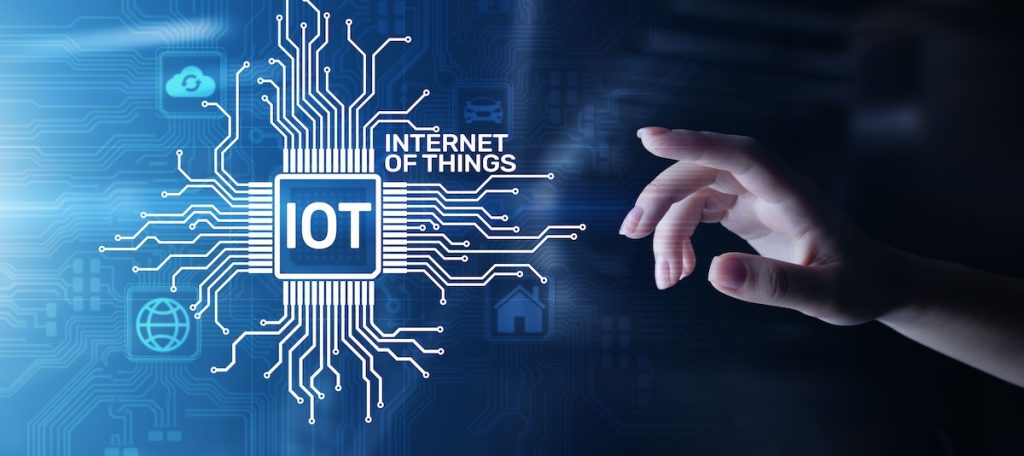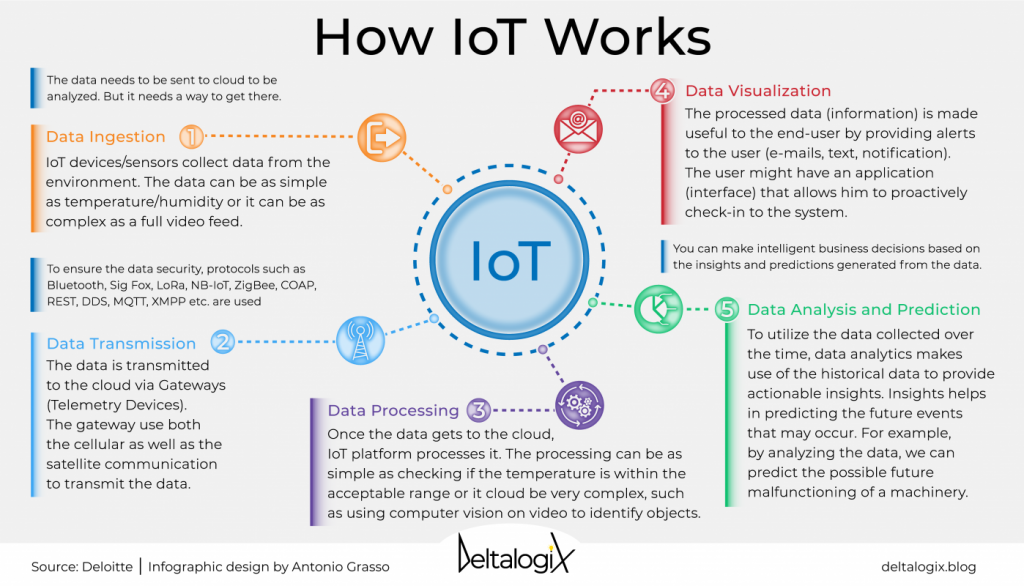What is the Internet of Things? IoT
What is the Internet of Things ? IoT
The Internet of Things (IoT), also called the Internet of Things, refers to the billions of devices located around the world that are now connected to the Internet, collecting and sharing data with each other.
Thanks to the advent of cheap computer chips and the ubiquitous “Wireless Networks” (Wireless Networks), it is possible that every “Thing” (meaning things) from a small tablet to a very large airplane The Internet is connected and becomes part of the Internet of Things (IoT).
Connecting things to the Internet and adding “Sensors” to them adds a level of digital intelligence to them; This intelligence allows objects to interact with other objects using real-time data without human intervention. The Internet of Things (IoT) makes the world around us smarter and more responsive, and merges the digital and physical worlds together.
In this article, to the question “What is the Internet of Things?” Answers are given and various topics related to the Internet of Things are comprehensively and fully investigated.
(Definition of Internet of Things)
The Internet of Things (IoT) is a topic about extending the power of the Internet to things beyond computers and smartphones and, in fact, to a wide range of things (things), processes and the environment. In the following, more detailed explanations are provided in this regard. Today, most people know that the Internet of Things is changing industries from agriculture and healthcare to manufacturing and any other industry.
But what is the Internet of Things or the Internet of Things?
When people search for the answer to the question “What is the Internet of Things?”(?What is IoT)
are searched in Google, usually highly technical and complex answers are presented in the search results.
For example, the following explanation of IoT is a specialized and technical definition of Internet of Things.
The Internet of Things (IoT) is a system of computing devices, mechanical and digital machines, objects, animals or people that are marked with unique identifiers and have the ability to transmit data over a network without the need for human-to-human or human-to-computer interactions.
People who were confused after reading the above definition should know that not only is there nothing to worry about, but many other readers of this definition have felt the same way.
Most people don’t want to ask the question “What is the Internet of Things?” at the beginning of their work.
Dive into the specialized and technical details of the Internet of Things. Therefore, below is a simple description of the concept of Internet of Things.
How do people who are reading this read this web page?
They do this using a personal computer, laptop, mobile or tablet.
Regardless of what device a person is using, it can be said with certainty that that device is connected to the Internet. Although connecting to the Internet has become an almost normal issue today, it is really a wonderful thing and provides people with various benefits that were not possible before.
To better understand the importance of internet connection and as an example in this regard, you can imagine mobile phones in the era when smartphones did not exist yet. One could make phone calls and send text messages (SMS); But he could not read books, watch movies or listen to music. These are just a few of the wonderful things that today’s smartphones can do using an Internet connection.
Connecting things to the Internet has many benefits. Today, almost all people have seen these advantages in smartphones, laptops and tablets and have benefited from them. In fact, it can be safely said that nowadays, phones, laptops, tablets and most other gadgets, if they do not have the possibility to connect to the Internet, seem useless and useless.
The issue of internet connection is not only very important for the mentioned devices, but this issue is true for all other “things” as well. The Internet of Things is actually a very simple concept and its meaning is that “everything in the world will be connected to the Internet”. The confusion surrounding the concept of Internet of Things does not originate from the fact that this concept is too tightly defined and short, but because it is too loosely defined and its concept is broad. Understanding the concept of IoT is difficult when there are so many examples and possibilities.
Examples of Internet of Things( IoT )
It should be said that almost any physical object, if it is possible to connect it to the Internet so that it can exchange information on the network without the need for human intervention, or if it can be controlled through the Internet, the ability to turn into an Internet device It has objects. An incandescent light bulb that can be turned on and off by a smartphone is an Internet of Things device.
As another example of an Internet of Things device, there can be a “Motion Sensor” or “Smart Thermostat” connected to the Internet in an office (Smart Office) or “street lights” “Connected Street Lights” pointed out.
An IoT device can be as cute as a children’s doll or as serious and complex as a driverless truck. Some large devices may contain many smaller IoT components.
Among these, we can mention the “jet engine”, which currently contains thousands of sensors that collect data and send it for real-time processing.
These works are done with the aim of ensuring the efficiency of the jet engine. On a larger scale, we can refer to smart city projects where different areas are filled with various sensors that help humans to understand and control the environment.
The term Internet of Things (IoT) is basically used for devices that, firstly, cannot be connected to the Internet normally (for example, a refrigerator is not usually connected to the Internet) and secondly, can be connected to a network of Other objects connected to the Internet interact independently of human actions.
Based on this, a “Personal Computer” or “Smart Phone” is generally not considered as an Internet of Things device despite being connected to the Internet, because normally it is possible to connect them to the Internet. Of course, it should also be noted that a smartphone is made of a large number of sensors that make up a smartphone.
Meanwhile, “Smart Watch”, “Smart Band” and other “Wearable Devices” are usually considered as smart devices.
What is the Internet of Industrial Things?
“Industrial Internet of Things” (IIoT) or the fourth industrial revolution or Industry 4.0 are all names that refer to the concept of “use of Internet of Things technology in business”.
The concept of Industrial Internet of Things is similar to the Internet of Things in normal mode, and in fact, Industrial Internet of Things devices are something like home Internet of Things devices; With the difference that the goal is to use a combination of sensors, wireless networks, “big data”. “Big Data”, “Artificial Intelligence” (AI) and “Data Analysis” are measurement and optimization of industrial processes.
If the Internet of Things is defined in the entire supply chain, instead of defining it only in one company, its effect can be much bigger and wider. Increasing labor efficiency and saving costs are two potential goals of the Industrial Internet of Things (IIoT); But IIoT can also create revenue streams for businesses.
For example, using the Industrial Internet of Things (IIoT), factories can sell predictive engine maintenance instead of just selling a single product such as an engine.
The difference between the Internet of Things and the Internet of Everything
The term “Internet of Things” (IoT) was first proposed in 1999 by an English entrepreneur named “Kevin Ashton” and referred to connections between physical objects; However, at present, its meaning is considered wider than the initial meaning presented for this phrase.
Currently, this concept is generally overlapped, mistaken and interfered with the concept of “Internet of Everything” (Internet of Everything | IoE). The Internet of Things (IoT) and Machine to Machine Communication (M2M) are subsets of the Internet of Things (IoE).
In the following, the difference between these three cases is defined by providing definitions of their concepts. It is worth noting that the differences in these concepts lead to different effects for consumers and businesses in these areas.
What is the Internet of Everything?
The Internet of Things (IoE) was formed and emerged during the natural development and evolution of the Internet of Things. The Internet of Everything (IoE) is essentially related to Cisco’s tactics to launch a new business domain.
But at the same time, the Internet of Everything (IoE) follows a broader concept of connectivity from the point of view of modern connectivity technologies.
The Internet of Everything (IoE) consists of four key elements consisting of all kinds of connectivity imaginable:
People, Things, Process and Data. In the following, each of these cases will be examined.
People: are considered as the final nodes connected through the Internet, to share information and activities. Examples of this include social networks, health and fitness sensors, and more.
Objects: physical sensors, devices, actuators, and other things that produce data or receive it from other sources. An example of this is smart thermostats and gadgets.
Data: Raw data is processed and analyzed and converted into useful information.
Processes: using connections between data, objects and people to gain value. Examples of this include using fitness equipment and social media to promote related health system offerings to prospective customers.















